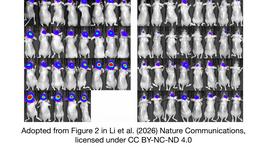CMN Weekly (19 July 2024) - Your Weekly CRISPR Medicine News
By: Karen O'Hanlon Cohrt - Jul. 19, 2024
CMN Intelligence - The World’s Most Comprehensive Intelligence Platform for CRISPR-Genomic Medicine and Gene-Editing Clinical Development
Providing market intelligence, data infrastructure, analytics, and reporting services for the global gene-editing sector. Read more...
Top picks
- Researchers in Australia, UK, Canada and Costa Rica present a possible new antidote for spitting cobra venom. They conducted a whole-genome CRISPR knockout screen in human cells to identify genes involved in the cellular response to the venom, and this highlighted several genes encoding proteoglycans, including heparan sulfate and heparin. Hypothesising that heparinoids (heparin-like polysaccharides that mimic the biological activities of heparin) could potentially block spitting cobra venom cytotoxicity, they demonstrate that the FDA-approved heparinoid tinzaparin could reduce tissue damage in mice when given via a medically relevant route and dose. Their findings were published in Science Translational Medicine.
- If you haven't already discovered it, then check out the brand new "Gene Editing in 180 Seconds" video series from WeDoCRISPR. In the latest instalment, Antonio Carusillo, Ph.D. and Manel Llado Santaeularia take you on a rapid tour through bridgeRNA, the latest technology from Patrick Hsu's lab at the Arc Institute, which could be a big rival to CRISPR! See it here!
Research
- In an article published yesterday in Science, researchers in California report the discovery and characterisation of an ancestral Cas13 ribonuclease, Cas13an. The team, led by Jennifer Doudna, shows that in spite of its small size compared to other Cas13s, Cas13an can selectively target green fluorescent protein (GFP) transcripts when co-expressed with GFP-targeting crRNAs in E. coli, and it also provided defence against diverse bacteriophages when co-expressed with selected phage-targeting crRNAs in E. coli. The findings add to the current understanding of CRISPR-Cas evolution and should create new opportunities for precise RNA editing. Read more here.
- Researchers in Swizterland and Austria have developed an in vivo single-cell CRISPR strategy to systematically investigate tissue-wide clonal dynamics of the 150 most frequently mutated squamous cell carcinoma genes. Their strategy combined ultrasound-guided in utero lentiviral microinjections, single-cell RNA sequencing and guide capture to longitudinally monitor clonal expansions and document their underlying gene programmes at single-cell transcriptomic resolution. The team uncovered a tumour necrosis factor (TNF) signalling module, which is dependent on TNF receptor 1 and involves macrophages, that acts as a generalisable driver of clonal expansions in epithelial tissues. Their findings were published in Nature earlier this week.
- A team at Iowa State University has found that CRISPR-Cas12a exhibits metal-dependent specificity switching. By profiling the specificity of Cas12a orthologues at a range of Mg2+ concentrations, they found that lowering Mg2+ concentration decreases cleavage defects caused by seed mismatches, while increasing the defects caused by PAM-distal mismatches. They also demonstrate that Cas12a can bind seed mutant targets more rapidly at low Mg2+ concentrations, resulting in faster cleavage. Their findings were published yesterday in Nucleic Acids Research.
- In an article published in Analytical Chemistry, scientists in Korea present a method for direct nucleic acid detection without pre-amplification, by combining the CRISPR/Cas12a system with signal enhancement based on light-up RNA aptamer transcription. In their hands, the strategy exhibited high sensitivity and specificity with a 22.4 fM detection limit, good accuracy, and stability for determining the target hepatitis B virus dsDNA in human serum samples. They propose their workflow as a universal sensing platform for ultrasensitive nucleic acid detection.
Industry
- Barcelona-headquartered Integra Therapeutics announced yesterday that it will receive a grant of €2.5 million and equity investment of up to €8 million from the European Commission via the European Innovation Council (EIC) Accelerator programme. According to a press release, the company will earmark the initial €2.5 million to pre-marketing activities of its FiCAT platform for T cell and haematopoietic stem cell engineering to develop cell therapies for rare diseases, autoimmune diseases, and oncology.
Reviews
- Genome-scale CRISPR-Cas9 screening in stem cells: theories, applications and challenges. This review summarises the progress within CRISPR-based functional genomics screening in stem cells, outlines practical considerations implemented in a range of scenarios, and explores the insights gleaned from CRISPR-based screen regarding cell fates, disease mechanisms and cell treatments in stem cell models.
- Unlocking biological mechanisms with integrative functional genomics approaches. This review provides a comprehensive overview of functional genomic screening technologies applicable to human cells, ranging from shRNA screens to modern CRISPR screens. The authors explore the integration of CRISPR platforms with single-cell approaches to monitor gene expression, chromatin accessibility, epigenetic regulation, and chromatin architecture following genetic perturbations at the -omics level.
- Transcriptional Repressor BCL11A in Erythroid Cells. This review provides an account of the research that identified BCL11A as stage-specific transcription factor that controls the switch from foetal to adult haemoglobin in erythroid cells. BCL11A is the target of several ongoing clinical programmes to develop new therapies for sickle cell disease and beta thalassemia, including the only approved CRISPR-based therapy, CASGEVY. The authors discuss future challenges including expanding access and infrastructure for delivery of genetic therapy to eligible patients, reducing potential toxicity and costs, exploring prospects for in vivo targeting of haematopoietic stem cells, and developing small molecule inhibitors of the BCL11A protein as an alternative option to gene and gene-editing therapy.
Perspectives and patent news
- A roadmap for affordable genetic medicines. Gene- and gene-editing therapies are the most expensive therapies on the market today, with list prices above $4 million per patient. In this perspective for Nature, gene-editing experts describe a potential pricing structure that they believe could reduce the per-patient cost tenfold, and propose a business model that distributes responsibilities while leveraging diverse funding sources. The authors also outline how academic licensing provisions, manufacturing innovation and supportive regulations can reduce cost and enable broader patient treatment.
- Ongoing CRISPR Patent Dispute Complicates Licensing but Hasn’t Deterred Gene-Editing Investment. This article in BioSpace provides the latest updates in the years-long CRISPR patent dispute.
News from CRISPR Medicine News
- On Monday, we highlighted a recent study carried out at the University of Bristol which indicates that the last universal common ancestor (LUCA) possessed an early form of the CRISPR-Cas immune system, dating back approximately 4.2 billion years. The findings suggest that CRISPR evolved just a few hundred million years after the planet formed. Read our highlight here.
- In our latest clinical update, we summarised recent news from four gene-editing trials sponsored by Beam Therapeutics, Intellia Therapeutics, Editas Medicine and KSQ Therapeutics. Read the update here.
**CRISPRMED25 - The 2nd CRISPR Medicine Conference, Copenhagen, Denmark, April 7-11, 2025**
Learn about the latest discoveries in CRISPR Medicine at the CRISPRMED25 Conference in Copenhagen, Denmark, April 7-11, 2025.
Tags
CLINICAL TRIALS
IND Enabling
Phase I
Phase II
Phase III
Gastric Cancer and Colorectal Cancer, CRC, (NCT07166263)
Sponsors:
Base Therapeutics (Shanghai) Co., Ltd.
Sponsors:
Base Therapeutics (Shanghai) Co., Ltd.
IND Enabling
Phase I
Phase II
Phase III
Relapsed or Refractory Acute Myeloid Leukemia, AML, (NCT06541444)
Sponsors:
Base Therapeutics (Shanghai) Co., Ltd.
Sponsors:
Base Therapeutics (Shanghai) Co., Ltd.
IND Enabling
Phase I
Phase II
Phase III







